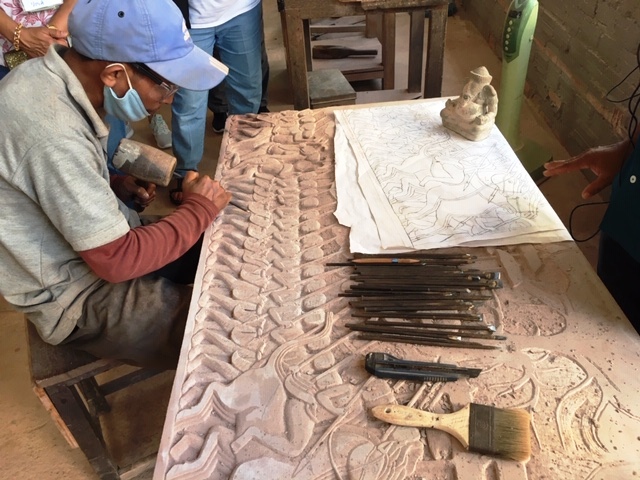Vocabulary: Hello in Cambodian--soos a day
Thank you in Cambodian--Ar-koon
Money: There are 4060 Cambodian riels to the US dollar but US dollars are also widely.
Today, Tuesday, after a 6 am wake up call and an early breakfast, we headed to the Bangkok airport for our 11:30 flight on Bangkok Air to Siem Reap, Cambodia. It was our first of four inner region flights and the first of the two international flights, so we needed to get there well in advance.
Since we got to the airport early, we had time to walk around. Sam took some amazing pictures of statues of a sacred story for Hindus, the Samudra Mantha, the churning of the Milk Ocean.
 |
| Churning of the milky ocean, part of creation story |
Siem Reap is in the NW corner of the country.
Angkor Wat is a Hindu temple complex in Cambodia and is the largest religious monument in the world, on a site measuring 162.6 hectares. Originally constructed as a Hindu temple dedicated to the god Vishnu for the Khmer Empire, it was gradually transformed into a Buddhist temple towards the end of the 12th century. But our stop there and to Angkor Thom will be tomorrow.
From lunch we went to Artisans Angkor, a special workshop created to train and employ 15-25-year-olds in rural areas in ancient Cambodian arts, so they can be gainfully employed and to keep those skills/traditions alive.
After taking an entrance test and passing, students picked a skill to learn In his/her one year training: Wood carving, sculpting with soap stone and sand stone, metal work,painting with acrylics on silk and lacquer on wood. Early on they also taught construction work
After 9 months, they are guaranteed a job if they wish to stay. Most of their products are sold in the country to hotels while internationally they are bought by private citizens, especially in Europe. We were extremely impressed. The program started in 1992 and now employs over 800 artisans in 48 workshops. They are guaranteed safe working conditions, fair compensation packages, and stay deeply attached to Cambodian culture.
After 9 months, they are guaranteed a job if they wish to stay. Most of their products are sold in the country to hotels while internationally they are bought by private citizens, especially in Europe. We were extremely impressed. The program started in 1992 and now employs over 800 artisans in 48 workshops. They are guaranteed safe working conditions, fair compensation packages, and stay deeply attached to Cambodian culture.
 |
| Chiseling |
 |
| Wood carving, from teak or rubber wood |
 |
| Sanding |
 |
| Metal Work |
 |
| This man has already worked carving this would table for 3 months and has a lot more to do |
 |
| Acrylic on Wood |
This lacquer on wood painting entitled Hands of Apsara was magnificent. It is a stunning rendition of three of the hand movements in traditional Khmer dancing. I was tempted to buy it but it was too early on our trip to get something this size.
 |
After checking into our hotel in Siem Reap, we went to a restaurant for dinner
 |
A beautiful stone carving of lilies in a pond hanging on the wall at the entrance of the restaurant |
 |
| Centerpiece on tables of folded lotus flowers |
 |
| Musician playing a traditional Cambodian bamboo xylophone, a Roneat Aek |
The food was tasty and presented in a beautiful manner.
and then watched a presentation of five traditional Cambodian dances. What a treat!
The first dance was with a lead dancer and a small group of young women. The dance is old from the Angkor period and was used to bless the king, country leaders, and official guests.
The second dance was the coconut shell or praying mantis dance, created in SE Cambodia. It was performed at weddings and other happy occasions.
The third dance, a woman and a man in a mask, was the Mekhala dance--a metaphor for good triumphing over evil and then working together.
Thanks to Jimmy for some of the pictures of the dancers.
The fourth dance was the peacock dance of the Kilat people who work polishing gems. The dance is related to Buddhism.
The final dance was the Apsara dance, named for the goddess of dance. Thousands of Apsara statues are in temple walks including at Angkor Wat.
The dancers were accompanied by drums, a wooden xylophone, and a singer. The costumes were spectacular.
We headed to bed with memories of the dancer and musicians. The next morning we were off to see the Angkor temples.
We headed to bed with memories of the dancer and musicians. The next morning we were off to see the Angkor temples.
.


























No comments:
Post a Comment